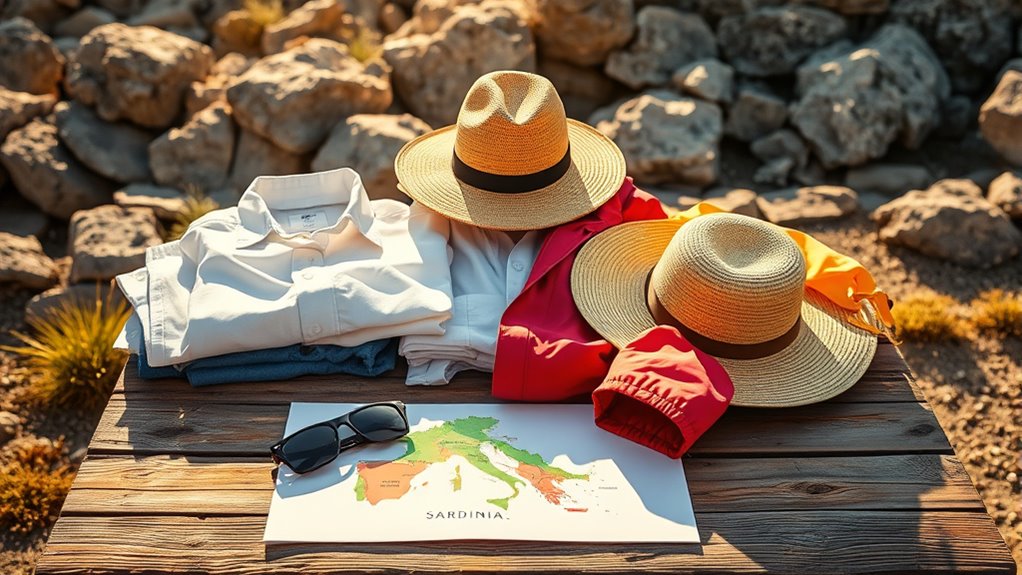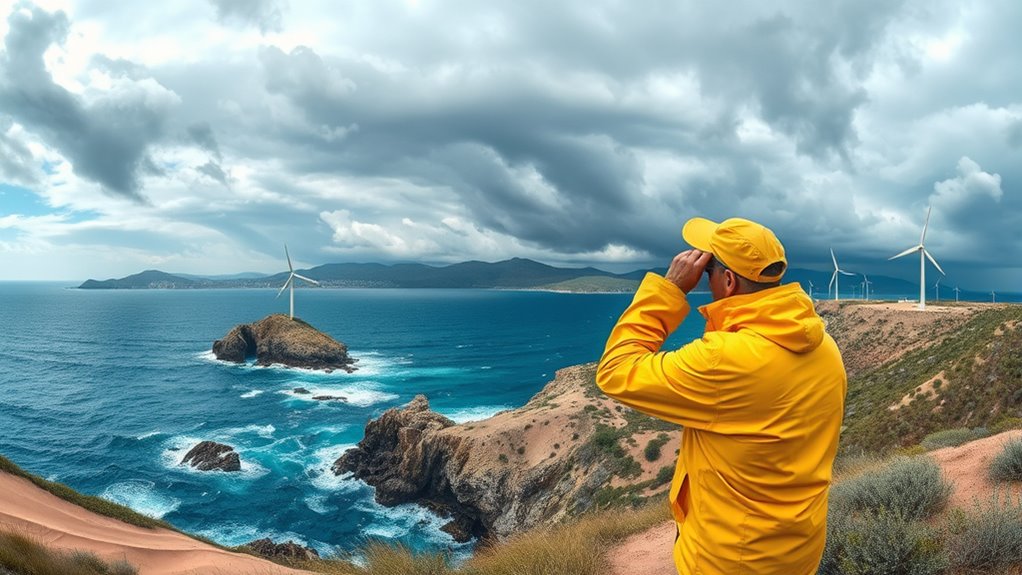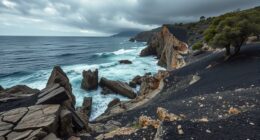To prep for Sardinian weather, pack versatile clothing for mild winters, such as layered sweaters and waterproof gear. In summer, wear lightweight, breathable fabrics and bring sun protection. For spring and autumn, include rain jackets, moisture-wicking layers, and sturdy footwear to handle unpredictable weather and variable temperatures. Be aware of how winds like mistral and sirocco can affect comfort and safety. Continuing will give you the know-how to enjoy Sardinia comfortably year-round.
Key Takeaways
- Pack layered clothing adaptable to Sardinia’s mild winters, hot summers, and variable spring and autumn weather.
- Bring sun protection, including broad-brimmed hats, high-SPF sunscreen, and UV sunglasses, especially in summer.
- Prepare waterproof gear and sturdy footwear for unpredictable rain, mountain conditions, and rugged terrains.
- Be mindful of regional differences: cooler, wetter highlands versus milder coastal areas when planning outdoor activities.
- Account for seasonal wind patterns like mistral and sirocco, which can affect comfort and outdoor safety.
Understanding Sardinian Climate Basics

Sardinia’s climate is characterized by its typical Mediterranean pattern, which means you’ll experience mild, relatively short, and fairly wet winters alongside long, hot, and sunny summers. Coastal winter temperatures rarely drop below 0°C in January, and summer highs often reach 35°C to over 40°C during heat waves. Summers are hot and dry, but sea breezes like the Maestrale help keep temperatures comfortable near the coast. Winters are mild along the coast but colder inland and in mountainous areas, where snow can occur more frequently. Rainfall is irregular, mainly falling in autumn and winter, with little rain in spring and almost none in summer. Expect plenty of sunshine from late spring through summer, especially along the coast, making Sardinia a warm and inviting destination year-round. Seasonal variations can also influence local agricultural practices and outdoor activity planning.
Preparing for Mild Winter Conditions

As winter approaches, make certain you’re dressed warmly when exploring Sardinia’s coast, especially during mornings and evenings. Prepare for mountain frost by bringing layers and waterproof gear if you plan to visit higher altitudes. Staying adaptable with your clothing ensures you’re comfortable, whether you’re enjoying mild coastal days or bracing for cooler inland temperatures. Being mindful of attention during your preparations can help you better anticipate changing weather conditions and adjust your wardrobe accordingly. Its less crowded during winter, so packing appropriately can help you fully enjoy the tranquil scenery without discomfort.
Dress Warmly for Coastal
Even though coastal winters in Sardinia are generally mild, it’s important to dress in layers to stay comfortable as temperatures fluctuate between day and night. During the day, temperatures range from 10°C to 20°C, so lightweight clothing with a medium-weight jacket or windbreaker keeps you comfortable. In the early mornings and evenings, when it drops to 5-10°C, add warm sweaters, long sleeves, or insulated layers. Coastal winds, especially the Mistral, can make it feel cooler, so windproof outerwear is helpful. Waterproof or water-resistant clothing protects against occasional rain and overcast days. Comfortable footwear suitable for damp terrain is also a good idea. By layering appropriately, you’ll stay warm and dry while enjoying Sardinia’s mild winter coastal scenery. Additionally, choosing appropriate outdoor gear can enhance comfort and protection against unpredictable weather conditions.
Prepare for Mountain Frost
While coastal winters in Sardinia remain relatively mild, venturing into the mountains introduces new challenges due to colder temperatures and frost. You’ll need to prepare for light but persistent frost and snowfall. Visualize:
- Frost forming on rocky slopes as clear, cold nights settle in.
- Snow blankets the higher peaks, hiding icy patches beneath.
- Early mornings bringing icy surfaces that demand careful footing.
- Wind-driven mist from mistral and scirocco winds dampening gear and intensifying cold.
In addition, understanding the Juicery World can help you stay energized and maintain your health during demanding outdoor conditions. Dress in insulating layers, waterproof outerwear, and thermal base layers to stay warm. Always check weather forecasts for sudden temperature drops or wind shifts. Carry extra clothing and gear to handle icy surfaces and changing conditions. Weather patterns in Sardinia can change quickly, especially in mountainous areas, so staying informed is crucial. Being prepared keeps your outdoor adventures safe and enjoyable in Sardinia’s mountain frost.
Getting Ready for Hot Summer Days

Preparing for hot summer days in Sardinia means choosing the right clothing and accessories to stay cool and protected. Opt for loose, lightweight fabrics like cotton or linen that breathe easily and help dissipate heat. Light-colored clothes reflect the sun’s rays, keeping you cooler. Don’t forget a broad-brimmed hat and high-SPF sunscreen to shield your skin from intense UV exposure during long sunny hours. Sunglasses with UV protection are essential for safeguarding your eyes. As temperatures drop slightly in the evening, lightweight layers are comfortable for outdoor dining or strolling along the coast. Staying adequately hydrated is vital to prevent overheating and maintain energy levels throughout the day. Seek shade during peak midday hours to protect yourself from the sun’s strongest rays. The region experiences low humidity, which helps you stay comfortable even during the hottest days. With these precautions, you’ll enjoy Sardinia’s summer sunshine while staying comfortable and protected throughout your day.
Packing for Springtime Excursions

When packing for spring excursions in Sardinia, make sure to bring layered clothing to handle changing temperatures. Don’t forget sun and rain gear to stay comfortable during unpredictable weather. Finally, choose sturdy footwear suited for outdoor activities like hiking and exploring the island’s trails. Trailer music can also be a helpful addition to your outdoor adventures, whether for setting a relaxing mood or energizing your day. Temperatures increase during April, so dressing in layers will help you stay comfortable as the weather varies throughout the day.
Layered Clothing Essentials
Spring weather in Sardinia can change quickly, so packing versatile, layered clothing is essential for comfortable excursions. To adapt to shifting temperatures and wind, consider these layers:
- Moisture-wicking base layers to keep you dry and regulate body temperature during warm days.
- Lightweight fleece or sweaters to add warmth during cool mornings or evenings.
- Windproof jackets or softshells that shield against coastal breezes without sacrificing breathability.
- Convertible pants or breathable trousers for versatility, allowing you to adjust to warmer or cooler conditions easily.
These layers help you respond to daily temperature swings, from daytime highs in the 70s°F to chilly nights near 48°F. Additionally, spring temperatures gradually increase from 60°F to 78°F, so layering allows you to stay comfortable as the weather warms up. Proper clothing layering not only ensures comfort but also helps protect against sudden weather changes. By combining these essentials, you’ll stay comfortable no matter how unpredictable Sardinian spring weather turns.
Sun and Rain Gear
As you pack for springtime excursions in Sardinia, it’s essential to include sun and rain gear that can adapt to changing weather conditions. Temperatures range from cool nights around 53°F (12°C) to daytime highs near 78°F (26°C), so lightweight, breathable clothing with UPF protection helps shield your skin without overheating. A broad-spectrum sunscreen is a must, along with wide-brimmed hats and UV-protective sunglasses to guard against intense midday sun. Since spring can bring scattered showers and wind, pack a compact, waterproof rain jacket and quick-dry clothing. Waterproof gaiters or over-shoes keep your feet dry on muddy trails. A small travel umbrella and waterproof covers for your backpack add extra protection, ensuring you stay comfortable and prepared for Sardinia’s spring weather shifts. Spring weather can be quite unpredictable, so having versatile gear ensures you enjoy your outdoor adventures regardless of sudden changes.
Footwear for Outdoors
Choosing the right footwear for outdoor activities in Sardinia guarantees comfort and safety as you explore its varied terrain. You’ll want shoes that handle different surfaces and weather. Imagine:
- Breathable mesh trail runners that keep your feet cool, preventing overheating during spring’s mild 15–25°C (59–77°F) days.
- Waterproof hiking boots with sturdy soles and good traction, perfect for rocky trails, archaeological sites, and muddy paths.
- Reinforced shoes with toe caps and heel counters to protect against rocks and uneven surfaces.
- Lightweight sneakers with moisture-wicking socks, ideal for casual walks on warm, dry days.
- Selecting footwear with appropriate color temperature adjustments ensures optimal visibility and comfort in changing outdoor lighting conditions.
Packing a couple of pairs ensures comfort, while adjustable closures and removable insoles let you customize fit. Prioritize durability and breathability for a spring Sardinian adventure.
Autumn Weather Considerations

Autumn in Sardinia offers generally mild and comfortable weather, making it an ideal time for outdoor activities. Daytime temperatures typically range from 20°C to 25°C, providing warm conditions for hiking and exploring. However, nights can drop to around 14°C, so bring layers for evenings. The sea remains warm, between 21°C and 24°C, allowing for swimming into late autumn. Expect regional differences: northern highlands are cooler and wetter, while coastal areas stay milder with breezes. October brings increased rainfall—about 40mm to 90mm—usually in short showers, so keep a light rain jacket handy. Humidity hovers around 70-75%, creating a fresh, pleasant climate. With about 6 hours of sunshine daily, early autumn offers ideal conditions for sightseeing and outdoor dining. Regularly assessing and adjusting your outdoor gear can help you make the most of these weather variations.
Navigating Wind Patterns and Their Effects

Understanding Sardinia’s wind patterns is essential for planning outdoor activities, especially since different winds influence the island’s climate and conditions throughout the year. You’ll notice how the wind shifts, shaping your experience on the coast and inland. Here’s what you might encounter:
Knowing Sardinia’s wind patterns helps plan outdoor activities and adapt to changing coastal and inland conditions.
- A gusty Mistral sweeping from the northwest, cooling the north and south and stirring up waves.
- Cold Tramontana winds in the north, gusting fiercely and bringing a chill.
- The warm Sirocco from the Sahara, dusting southern beaches with reddish haze.
- Steady thermal winds during summer afternoons, sometimes exceeding 20 knots, especially on southern beaches like Poetto.
- Understanding weather patterns helps in anticipating how these winds will influence your outdoor plans and overall comfort.
These patterns affect weather, sea conditions, and outdoor comfort, so paying attention helps you prep accordingly.
Dressing for Temperature Variations

Wind patterns considerably influence Sardinia’s weather, but paying attention to temperature variations helps you stay comfortable year-round. In winter, temperatures range from about 42°F to 58°F, especially inland and in mountains, so layering is essential—think thermal base layers, wool sweaters, and insulated coats. Waterproof outerwear keeps you dry during rain showers. In spring and autumn, temperatures fluctuate daily, so wear long-sleeved shirts, light sweaters, and packable jackets for cooler mornings and evenings. Summers are hot, with highs of 77°F to 95°F, making lightweight, loose-fitting, and light-colored clothing ideal. Breathable fabrics like cotton and linen help manage heat and humidity. Remember, coastal areas are milder, but nights can be cooler, so include versatile layers to adapt to temperature swings across regions and seasons. Understanding seasonal temperature changes can help you plan your wardrobe effectively and ensure comfort throughout your trip.
Planning Activities Around Rainfall and Humidity

Rainfall and humidity considerably impact your plans in Sardinia, especially during the wetter months. Autumn and winter bring heavy rains, with November and December being the wettest—sometimes over 1,000 mm in mountainous regions. To adapt, consider:
- Scheduling indoor visits to museums, historical sites, or shopping centers when rain strikes.
- Hiking during the spring, when rainfall rejuvenates landscapes and trails are less muddy.
- Enjoying water sports like kayaking in calmer conditions, often found in summer or dry spells.
- Participating in festivals and cultural events that flourish during wetter months, offering authentic local experiences.
- Monitoring the weather forecast to stay updated on rainfall patterns, ensuring your outdoor plans remain feasible.
Planning your activities around these weather patterns guarantees you stay comfortable and make the most of Sardinia’s diverse seasons, rain or shine.
Making the Most of Sea and Outdoor Activities

Sardinia’s stunning coastline offers a multitude of outdoor activities that can be enjoyed year-round, provided you choose the right spots and times. With its diverse beaches—from expansive sandy shores to sheltered coves—you can swim, snorkel, or relax under the sun. Explore the high dunes at Piscinas or paddle through saltwater lagoons perfect for kayaking and bird watching. Marine protected areas like Capo Caccia host over 100 sea caves, ideal for diving and exploring marine biodiversity. Seasonal winds like the mistral create excellent conditions for sailing and windsurfing, especially in spring and autumn. Keep in mind, summer offers warm waters and ideal beach weather, while winter’s cooler temperatures attract surfers and nature enthusiasts. Oceans cover 70% of Earth’s surface, producing over 50% of oxygen and absorbing about 30% of CO2 emissions annually. Adjust your plans accordingly to make the most of Sardinia’s vibrant sea and outdoor scene.
Frequently Asked Questions
What Should I Pack for Unpredictable Transitional Season Weather?
When packing for unpredictable transitional season weather, you should bring versatile layered clothing like long-sleeve shirts, light sweaters, and mid-weight jackets. Include waterproof and windproof outerwear such as rain jackets and shells for sudden showers and strong winds. Don’t forget waterproof shoes or boots, a compact umbrella, hats, scarves, and sunglasses. These essentials help you stay comfortable and adaptable through temperature swings, rain, and windy conditions.
How Can I Stay Comfortable During Sudden Wind Gusts?
Imagine standing on a breezy hill, feeling both the invigorating gusts and the chill they bring. To stay comfortable, wear wind-resistant layers that block out the wind while keeping you warm. Secure your hat and belongings, and seek natural or built shelter when gusts grow strong. Keep an eye on the weather, move cautiously, and adjust your clothing as needed, so you enjoy the breeze without discomfort or risk.
Are There Specific Clothing Tips for Coastal Versus Inland Areas?
You should choose clothing based on whether you’re in coastal or inland Sardinia. At the coast, wear lightweight, breathable fabrics like linen or cotton, and bring hats and sunglasses for sun protection. Expect cooler evenings with sea breezes, so pack a light sweater. Inland, prepare for higher temperatures and cooler nights with layered clothing, including warmer layers and waterproof gear for wetter, colder winters, especially in higher elevations.
How Do Weather Changes Affect Outdoor Activity Planning?
Did you know Sardinia’s summer temperatures can hit 35°C? Weather changes greatly influence your outdoor plans. During summer, hot days and sirocco winds may cause heat stress, so schedule activities early or late in the day. Autumn and spring offer milder temperatures, ideal for hiking and exploring. Rain is rare in summer but more common in winter and fall, so keep an eye on forecasts to make certain your outdoor adventures stay enjoyable and safe.
When Is the Best Time to Avoid Crowds and Weather Issues?
You want to avoid crowds and weather issues, so consider visiting Sardinia in early April or late September. During these shoulder months, you’ll find milder temperatures, fewer tourists, and plenty of sunshine. Avoid mid-August, when Ferragosto draws huge crowds and prices spike. Traveling in these months allows you to enjoy cultural festivals, outdoor activities, and sightseeing without the summer rush or extreme heat, making your trip more enjoyable.
Conclusion
As you pack your bag and chart your plans, you’ll notice how Sardinia’s changing weather mirrors the vibrant seasons around you—like the shifting tides shaping the coastline. With each breeze, sunbeam, or raindrop, you become more in tune with the island’s rhythm. Embrace these moments, knowing your preparations will lead to unforgettable adventures, whether basking on sun-drenched beaches or exploring lush spring trails. Sardinia’s weather becomes your guide to making every trip memorable.









